SNPG959: Workplace Culture's Impact on Clinical Care, Patient Outcomes
VerifiedAdded on 2023/04/03
|12
|2969
|190
Essay
AI Summary
This essay explores the concept of workplace culture within a healthcare setting, specifically focusing on its impact on clinical care, patient outcomes, and staff satisfaction. It highlights the significance of organizational culture and its various elements, such as customs, traditions, and leadership styles, in shaping the work environment. The essay also delves into how communication processes and management practices influence employee behavior and, consequently, affect the quality of care provided. It emphasizes the importance of person-centered care and the challenges leaders face in establishing a favorable workplace culture, including addressing employee resistance to change and providing appropriate motivation. The essay concludes by discussing strategies for enhancing employee engagement, such as assigning meaningful tasks and providing adequate training, to improve overall workplace efficiency and patient outcomes.
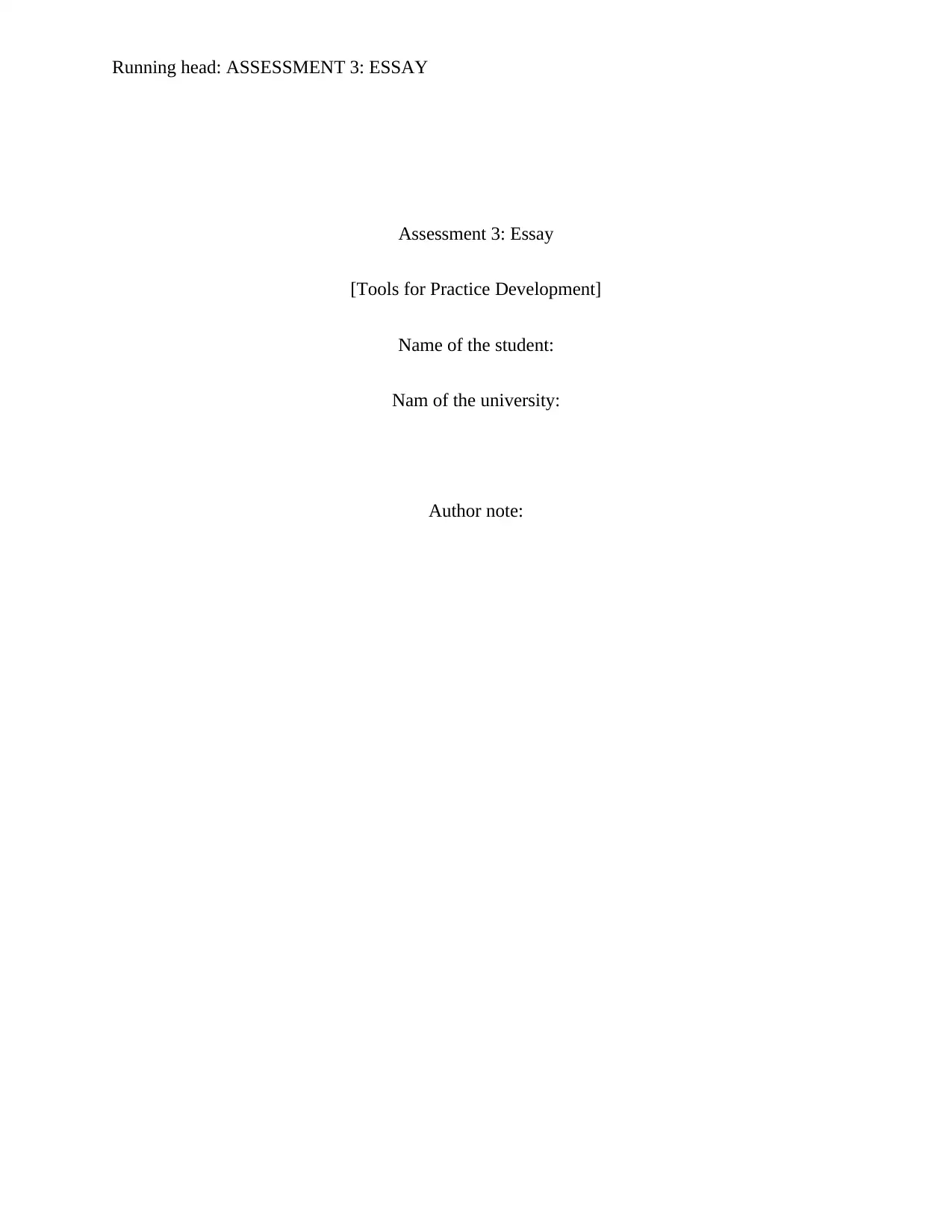
Running head: ASSESSMENT 3: ESSAY
Assessment 3: Essay
[Tools for Practice Development]
Name of the student:
Nam of the university:
Author note:
Assessment 3: Essay
[Tools for Practice Development]
Name of the student:
Nam of the university:
Author note:
Paraphrase This Document
Need a fresh take? Get an instant paraphrase of this document with our AI Paraphraser
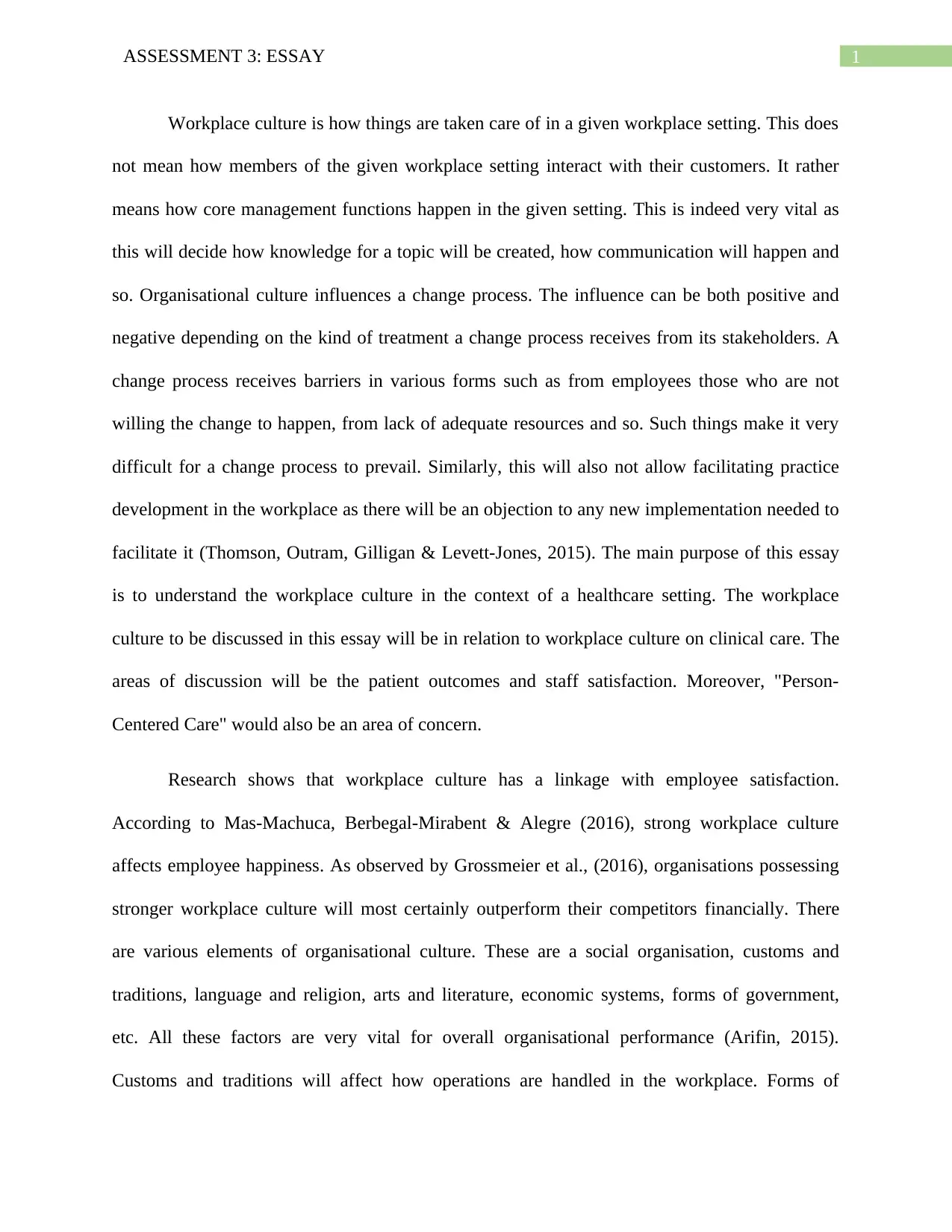
1ASSESSMENT 3: ESSAY
Workplace culture is how things are taken care of in a given workplace setting. This does
not mean how members of the given workplace setting interact with their customers. It rather
means how core management functions happen in the given setting. This is indeed very vital as
this will decide how knowledge for a topic will be created, how communication will happen and
so. Organisational culture influences a change process. The influence can be both positive and
negative depending on the kind of treatment a change process receives from its stakeholders. A
change process receives barriers in various forms such as from employees those who are not
willing the change to happen, from lack of adequate resources and so. Such things make it very
difficult for a change process to prevail. Similarly, this will also not allow facilitating practice
development in the workplace as there will be an objection to any new implementation needed to
facilitate it (Thomson, Outram, Gilligan & Levett-Jones, 2015). The main purpose of this essay
is to understand the workplace culture in the context of a healthcare setting. The workplace
culture to be discussed in this essay will be in relation to workplace culture on clinical care. The
areas of discussion will be the patient outcomes and staff satisfaction. Moreover, "Person-
Centered Care" would also be an area of concern.
Research shows that workplace culture has a linkage with employee satisfaction.
According to Mas-Machuca, Berbegal-Mirabent & Alegre (2016), strong workplace culture
affects employee happiness. As observed by Grossmeier et al., (2016), organisations possessing
stronger workplace culture will most certainly outperform their competitors financially. There
are various elements of organisational culture. These are a social organisation, customs and
traditions, language and religion, arts and literature, economic systems, forms of government,
etc. All these factors are very vital for overall organisational performance (Arifin, 2015).
Customs and traditions will affect how operations are handled in the workplace. Forms of
Workplace culture is how things are taken care of in a given workplace setting. This does
not mean how members of the given workplace setting interact with their customers. It rather
means how core management functions happen in the given setting. This is indeed very vital as
this will decide how knowledge for a topic will be created, how communication will happen and
so. Organisational culture influences a change process. The influence can be both positive and
negative depending on the kind of treatment a change process receives from its stakeholders. A
change process receives barriers in various forms such as from employees those who are not
willing the change to happen, from lack of adequate resources and so. Such things make it very
difficult for a change process to prevail. Similarly, this will also not allow facilitating practice
development in the workplace as there will be an objection to any new implementation needed to
facilitate it (Thomson, Outram, Gilligan & Levett-Jones, 2015). The main purpose of this essay
is to understand the workplace culture in the context of a healthcare setting. The workplace
culture to be discussed in this essay will be in relation to workplace culture on clinical care. The
areas of discussion will be the patient outcomes and staff satisfaction. Moreover, "Person-
Centered Care" would also be an area of concern.
Research shows that workplace culture has a linkage with employee satisfaction.
According to Mas-Machuca, Berbegal-Mirabent & Alegre (2016), strong workplace culture
affects employee happiness. As observed by Grossmeier et al., (2016), organisations possessing
stronger workplace culture will most certainly outperform their competitors financially. There
are various elements of organisational culture. These are a social organisation, customs and
traditions, language and religion, arts and literature, economic systems, forms of government,
etc. All these factors are very vital for overall organisational performance (Arifin, 2015).
Customs and traditions will affect how operations are handled in the workplace. Forms of
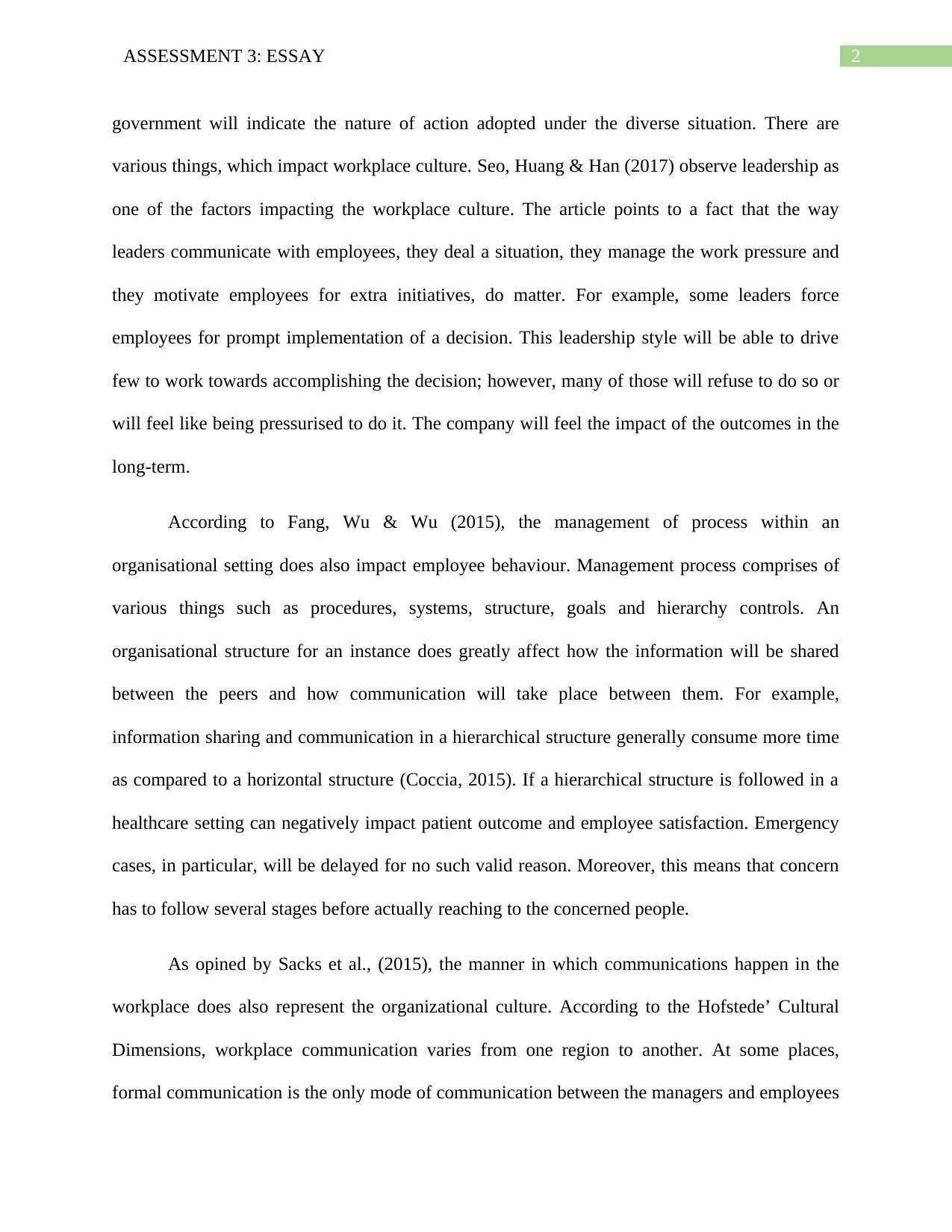
2ASSESSMENT 3: ESSAY
government will indicate the nature of action adopted under the diverse situation. There are
various things, which impact workplace culture. Seo, Huang & Han (2017) observe leadership as
one of the factors impacting the workplace culture. The article points to a fact that the way
leaders communicate with employees, they deal a situation, they manage the work pressure and
they motivate employees for extra initiatives, do matter. For example, some leaders force
employees for prompt implementation of a decision. This leadership style will be able to drive
few to work towards accomplishing the decision; however, many of those will refuse to do so or
will feel like being pressurised to do it. The company will feel the impact of the outcomes in the
long-term.
According to Fang, Wu & Wu (2015), the management of process within an
organisational setting does also impact employee behaviour. Management process comprises of
various things such as procedures, systems, structure, goals and hierarchy controls. An
organisational structure for an instance does greatly affect how the information will be shared
between the peers and how communication will take place between them. For example,
information sharing and communication in a hierarchical structure generally consume more time
as compared to a horizontal structure (Coccia, 2015). If a hierarchical structure is followed in a
healthcare setting can negatively impact patient outcome and employee satisfaction. Emergency
cases, in particular, will be delayed for no such valid reason. Moreover, this means that concern
has to follow several stages before actually reaching to the concerned people.
As opined by Sacks et al., (2015), the manner in which communications happen in the
workplace does also represent the organizational culture. According to the Hofstede’ Cultural
Dimensions, workplace communication varies from one region to another. At some places,
formal communication is the only mode of communication between the managers and employees
government will indicate the nature of action adopted under the diverse situation. There are
various things, which impact workplace culture. Seo, Huang & Han (2017) observe leadership as
one of the factors impacting the workplace culture. The article points to a fact that the way
leaders communicate with employees, they deal a situation, they manage the work pressure and
they motivate employees for extra initiatives, do matter. For example, some leaders force
employees for prompt implementation of a decision. This leadership style will be able to drive
few to work towards accomplishing the decision; however, many of those will refuse to do so or
will feel like being pressurised to do it. The company will feel the impact of the outcomes in the
long-term.
According to Fang, Wu & Wu (2015), the management of process within an
organisational setting does also impact employee behaviour. Management process comprises of
various things such as procedures, systems, structure, goals and hierarchy controls. An
organisational structure for an instance does greatly affect how the information will be shared
between the peers and how communication will take place between them. For example,
information sharing and communication in a hierarchical structure generally consume more time
as compared to a horizontal structure (Coccia, 2015). If a hierarchical structure is followed in a
healthcare setting can negatively impact patient outcome and employee satisfaction. Emergency
cases, in particular, will be delayed for no such valid reason. Moreover, this means that concern
has to follow several stages before actually reaching to the concerned people.
As opined by Sacks et al., (2015), the manner in which communications happen in the
workplace does also represent the organizational culture. According to the Hofstede’ Cultural
Dimensions, workplace communication varies from one region to another. At some places,
formal communication is the only mode of communication between the managers and employees
⊘ This is a preview!⊘
Do you want full access?
Subscribe today to unlock all pages.

Trusted by 1+ million students worldwide
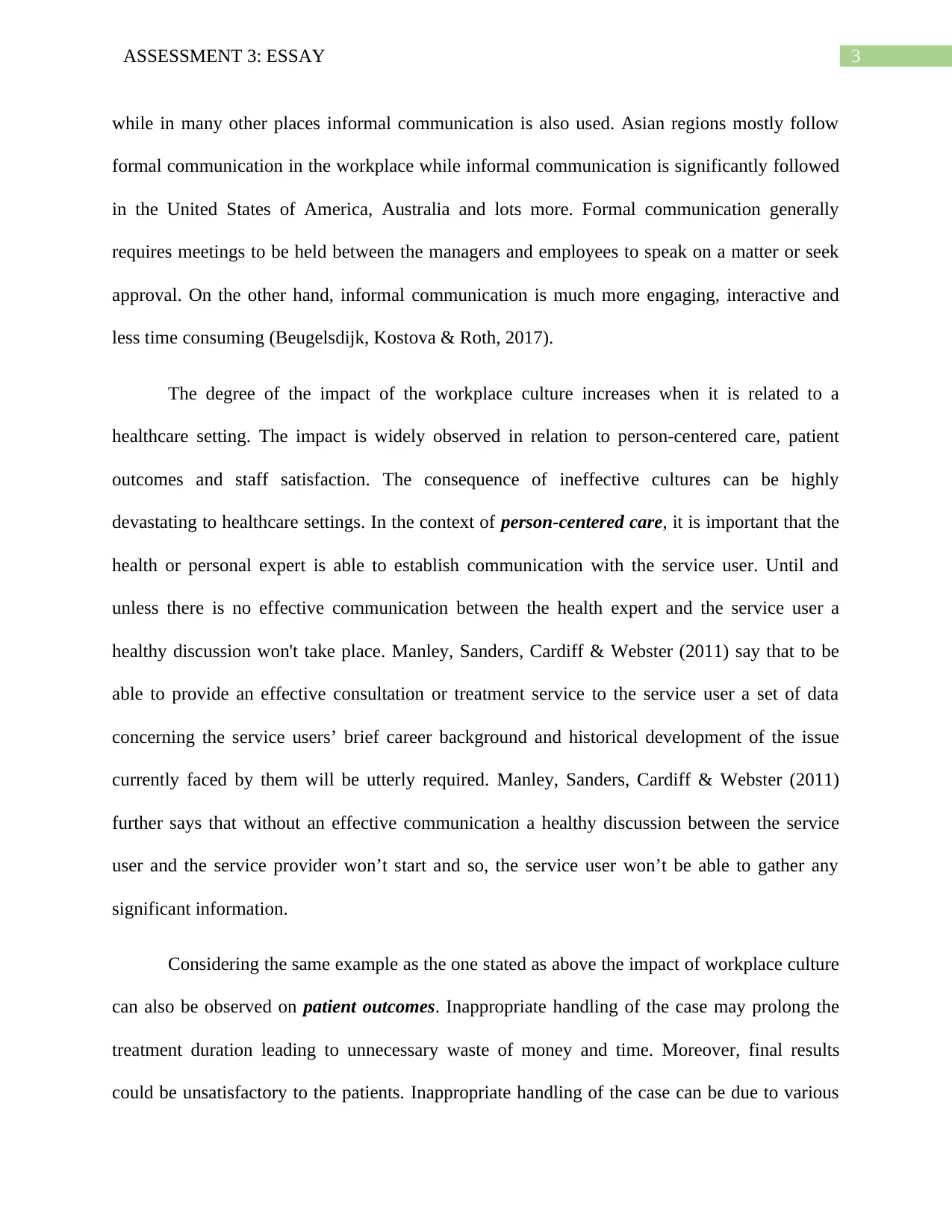
3ASSESSMENT 3: ESSAY
while in many other places informal communication is also used. Asian regions mostly follow
formal communication in the workplace while informal communication is significantly followed
in the United States of America, Australia and lots more. Formal communication generally
requires meetings to be held between the managers and employees to speak on a matter or seek
approval. On the other hand, informal communication is much more engaging, interactive and
less time consuming (Beugelsdijk, Kostova & Roth, 2017).
The degree of the impact of the workplace culture increases when it is related to a
healthcare setting. The impact is widely observed in relation to person-centered care, patient
outcomes and staff satisfaction. The consequence of ineffective cultures can be highly
devastating to healthcare settings. In the context of person-centered care, it is important that the
health or personal expert is able to establish communication with the service user. Until and
unless there is no effective communication between the health expert and the service user a
healthy discussion won't take place. Manley, Sanders, Cardiff & Webster (2011) say that to be
able to provide an effective consultation or treatment service to the service user a set of data
concerning the service users’ brief career background and historical development of the issue
currently faced by them will be utterly required. Manley, Sanders, Cardiff & Webster (2011)
further says that without an effective communication a healthy discussion between the service
user and the service provider won’t start and so, the service user won’t be able to gather any
significant information.
Considering the same example as the one stated as above the impact of workplace culture
can also be observed on patient outcomes. Inappropriate handling of the case may prolong the
treatment duration leading to unnecessary waste of money and time. Moreover, final results
could be unsatisfactory to the patients. Inappropriate handling of the case can be due to various
while in many other places informal communication is also used. Asian regions mostly follow
formal communication in the workplace while informal communication is significantly followed
in the United States of America, Australia and lots more. Formal communication generally
requires meetings to be held between the managers and employees to speak on a matter or seek
approval. On the other hand, informal communication is much more engaging, interactive and
less time consuming (Beugelsdijk, Kostova & Roth, 2017).
The degree of the impact of the workplace culture increases when it is related to a
healthcare setting. The impact is widely observed in relation to person-centered care, patient
outcomes and staff satisfaction. The consequence of ineffective cultures can be highly
devastating to healthcare settings. In the context of person-centered care, it is important that the
health or personal expert is able to establish communication with the service user. Until and
unless there is no effective communication between the health expert and the service user a
healthy discussion won't take place. Manley, Sanders, Cardiff & Webster (2011) say that to be
able to provide an effective consultation or treatment service to the service user a set of data
concerning the service users’ brief career background and historical development of the issue
currently faced by them will be utterly required. Manley, Sanders, Cardiff & Webster (2011)
further says that without an effective communication a healthy discussion between the service
user and the service provider won’t start and so, the service user won’t be able to gather any
significant information.
Considering the same example as the one stated as above the impact of workplace culture
can also be observed on patient outcomes. Inappropriate handling of the case may prolong the
treatment duration leading to unnecessary waste of money and time. Moreover, final results
could be unsatisfactory to the patients. Inappropriate handling of the case can be due to various
Paraphrase This Document
Need a fresh take? Get an instant paraphrase of this document with our AI Paraphraser
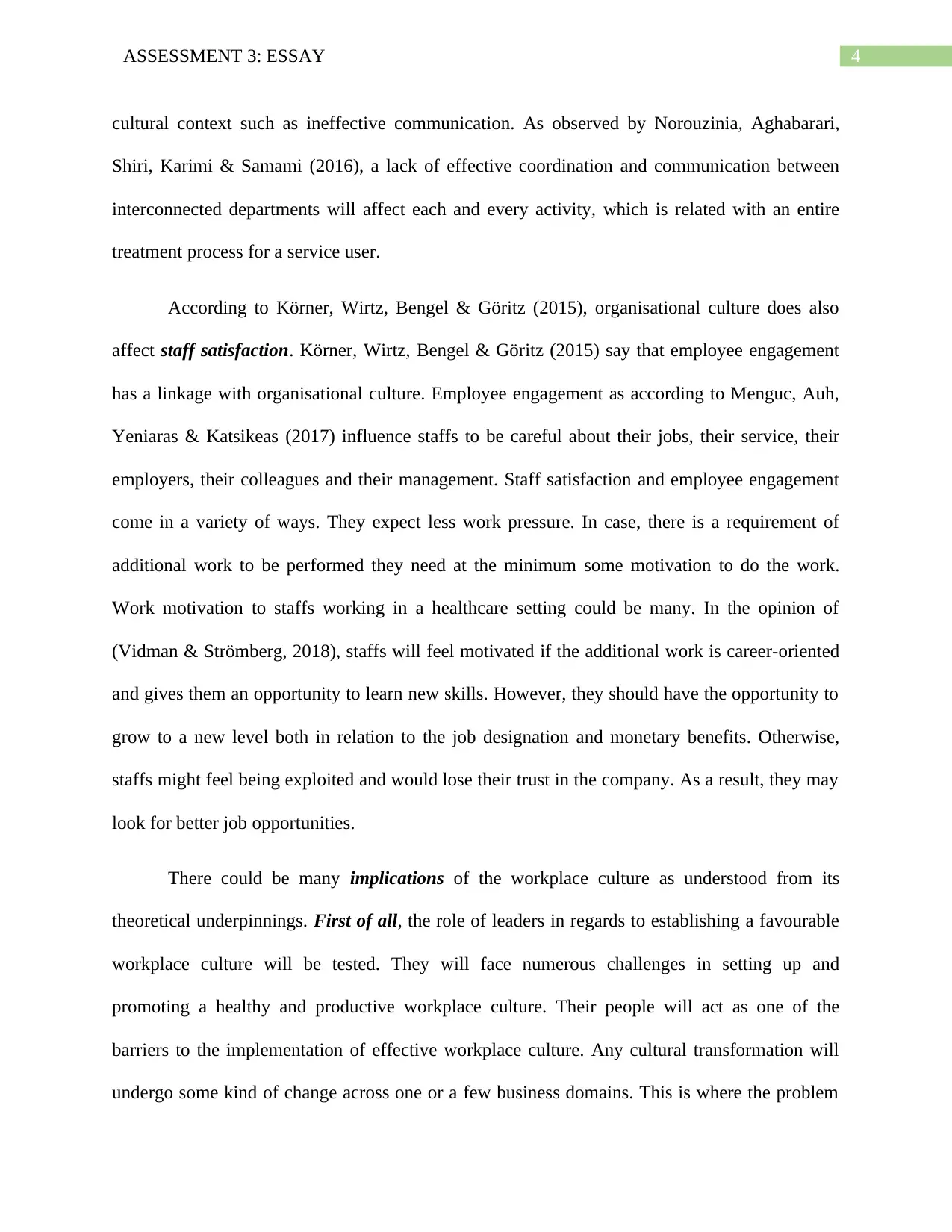
4ASSESSMENT 3: ESSAY
cultural context such as ineffective communication. As observed by Norouzinia, Aghabarari,
Shiri, Karimi & Samami (2016), a lack of effective coordination and communication between
interconnected departments will affect each and every activity, which is related with an entire
treatment process for a service user.
According to Körner, Wirtz, Bengel & Göritz (2015), organisational culture does also
affect staff satisfaction. Körner, Wirtz, Bengel & Göritz (2015) say that employee engagement
has a linkage with organisational culture. Employee engagement as according to Menguc, Auh,
Yeniaras & Katsikeas (2017) influence staffs to be careful about their jobs, their service, their
employers, their colleagues and their management. Staff satisfaction and employee engagement
come in a variety of ways. They expect less work pressure. In case, there is a requirement of
additional work to be performed they need at the minimum some motivation to do the work.
Work motivation to staffs working in a healthcare setting could be many. In the opinion of
(Vidman & Strömberg, 2018), staffs will feel motivated if the additional work is career-oriented
and gives them an opportunity to learn new skills. However, they should have the opportunity to
grow to a new level both in relation to the job designation and monetary benefits. Otherwise,
staffs might feel being exploited and would lose their trust in the company. As a result, they may
look for better job opportunities.
There could be many implications of the workplace culture as understood from its
theoretical underpinnings. First of all, the role of leaders in regards to establishing a favourable
workplace culture will be tested. They will face numerous challenges in setting up and
promoting a healthy and productive workplace culture. Their people will act as one of the
barriers to the implementation of effective workplace culture. Any cultural transformation will
undergo some kind of change across one or a few business domains. This is where the problem
cultural context such as ineffective communication. As observed by Norouzinia, Aghabarari,
Shiri, Karimi & Samami (2016), a lack of effective coordination and communication between
interconnected departments will affect each and every activity, which is related with an entire
treatment process for a service user.
According to Körner, Wirtz, Bengel & Göritz (2015), organisational culture does also
affect staff satisfaction. Körner, Wirtz, Bengel & Göritz (2015) say that employee engagement
has a linkage with organisational culture. Employee engagement as according to Menguc, Auh,
Yeniaras & Katsikeas (2017) influence staffs to be careful about their jobs, their service, their
employers, their colleagues and their management. Staff satisfaction and employee engagement
come in a variety of ways. They expect less work pressure. In case, there is a requirement of
additional work to be performed they need at the minimum some motivation to do the work.
Work motivation to staffs working in a healthcare setting could be many. In the opinion of
(Vidman & Strömberg, 2018), staffs will feel motivated if the additional work is career-oriented
and gives them an opportunity to learn new skills. However, they should have the opportunity to
grow to a new level both in relation to the job designation and monetary benefits. Otherwise,
staffs might feel being exploited and would lose their trust in the company. As a result, they may
look for better job opportunities.
There could be many implications of the workplace culture as understood from its
theoretical underpinnings. First of all, the role of leaders in regards to establishing a favourable
workplace culture will be tested. They will face numerous challenges in setting up and
promoting a healthy and productive workplace culture. Their people will act as one of the
barriers to the implementation of effective workplace culture. Any cultural transformation will
undergo some kind of change across one or a few business domains. This is where the problem
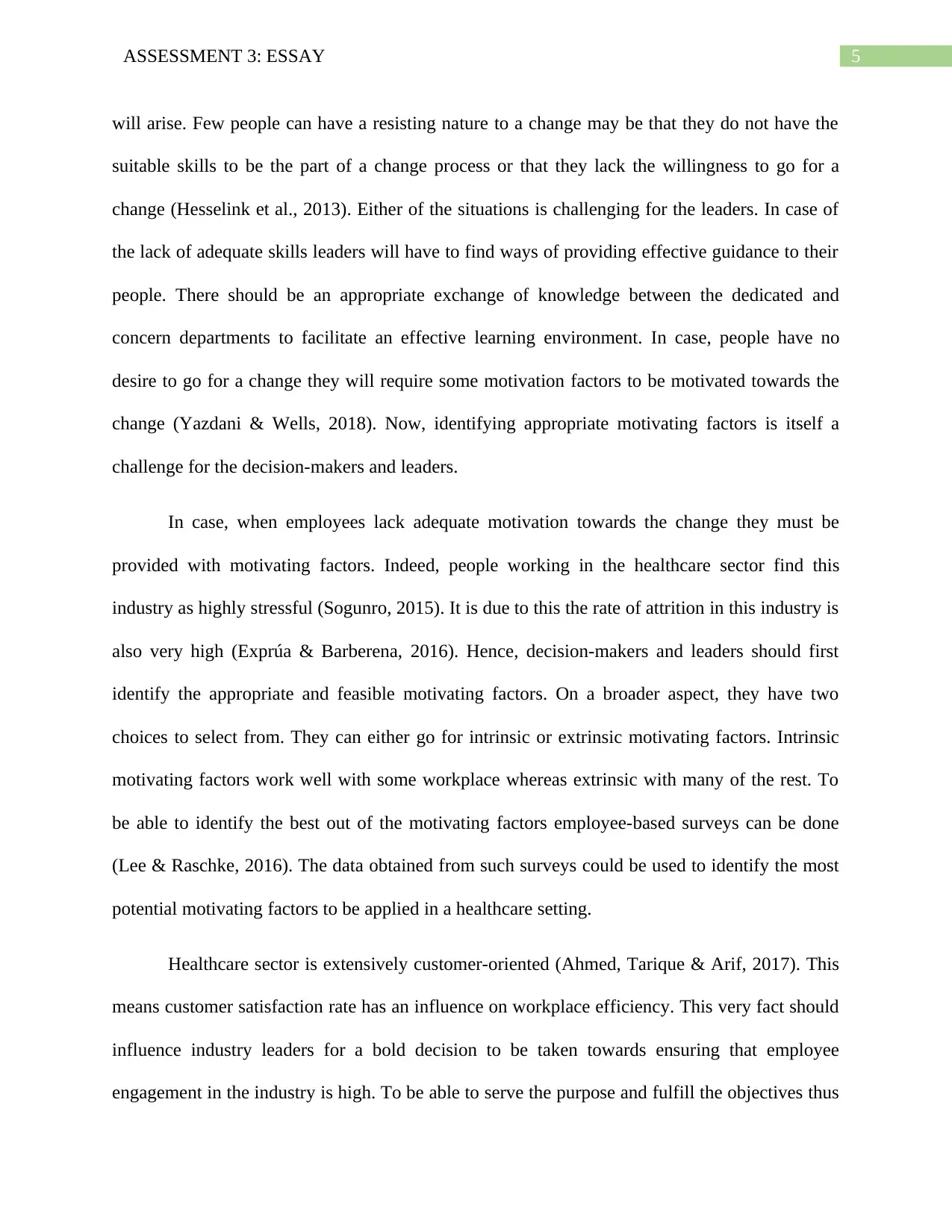
5ASSESSMENT 3: ESSAY
will arise. Few people can have a resisting nature to a change may be that they do not have the
suitable skills to be the part of a change process or that they lack the willingness to go for a
change (Hesselink et al., 2013). Either of the situations is challenging for the leaders. In case of
the lack of adequate skills leaders will have to find ways of providing effective guidance to their
people. There should be an appropriate exchange of knowledge between the dedicated and
concern departments to facilitate an effective learning environment. In case, people have no
desire to go for a change they will require some motivation factors to be motivated towards the
change (Yazdani & Wells, 2018). Now, identifying appropriate motivating factors is itself a
challenge for the decision-makers and leaders.
In case, when employees lack adequate motivation towards the change they must be
provided with motivating factors. Indeed, people working in the healthcare sector find this
industry as highly stressful (Sogunro, 2015). It is due to this the rate of attrition in this industry is
also very high (Exprúa & Barberena, 2016). Hence, decision-makers and leaders should first
identify the appropriate and feasible motivating factors. On a broader aspect, they have two
choices to select from. They can either go for intrinsic or extrinsic motivating factors. Intrinsic
motivating factors work well with some workplace whereas extrinsic with many of the rest. To
be able to identify the best out of the motivating factors employee-based surveys can be done
(Lee & Raschke, 2016). The data obtained from such surveys could be used to identify the most
potential motivating factors to be applied in a healthcare setting.
Healthcare sector is extensively customer-oriented (Ahmed, Tarique & Arif, 2017). This
means customer satisfaction rate has an influence on workplace efficiency. This very fact should
influence industry leaders for a bold decision to be taken towards ensuring that employee
engagement in the industry is high. To be able to serve the purpose and fulfill the objectives thus
will arise. Few people can have a resisting nature to a change may be that they do not have the
suitable skills to be the part of a change process or that they lack the willingness to go for a
change (Hesselink et al., 2013). Either of the situations is challenging for the leaders. In case of
the lack of adequate skills leaders will have to find ways of providing effective guidance to their
people. There should be an appropriate exchange of knowledge between the dedicated and
concern departments to facilitate an effective learning environment. In case, people have no
desire to go for a change they will require some motivation factors to be motivated towards the
change (Yazdani & Wells, 2018). Now, identifying appropriate motivating factors is itself a
challenge for the decision-makers and leaders.
In case, when employees lack adequate motivation towards the change they must be
provided with motivating factors. Indeed, people working in the healthcare sector find this
industry as highly stressful (Sogunro, 2015). It is due to this the rate of attrition in this industry is
also very high (Exprúa & Barberena, 2016). Hence, decision-makers and leaders should first
identify the appropriate and feasible motivating factors. On a broader aspect, they have two
choices to select from. They can either go for intrinsic or extrinsic motivating factors. Intrinsic
motivating factors work well with some workplace whereas extrinsic with many of the rest. To
be able to identify the best out of the motivating factors employee-based surveys can be done
(Lee & Raschke, 2016). The data obtained from such surveys could be used to identify the most
potential motivating factors to be applied in a healthcare setting.
Healthcare sector is extensively customer-oriented (Ahmed, Tarique & Arif, 2017). This
means customer satisfaction rate has an influence on workplace efficiency. This very fact should
influence industry leaders for a bold decision to be taken towards ensuring that employee
engagement in the industry is high. To be able to serve the purpose and fulfill the objectives thus
⊘ This is a preview!⊘
Do you want full access?
Subscribe today to unlock all pages.

Trusted by 1+ million students worldwide
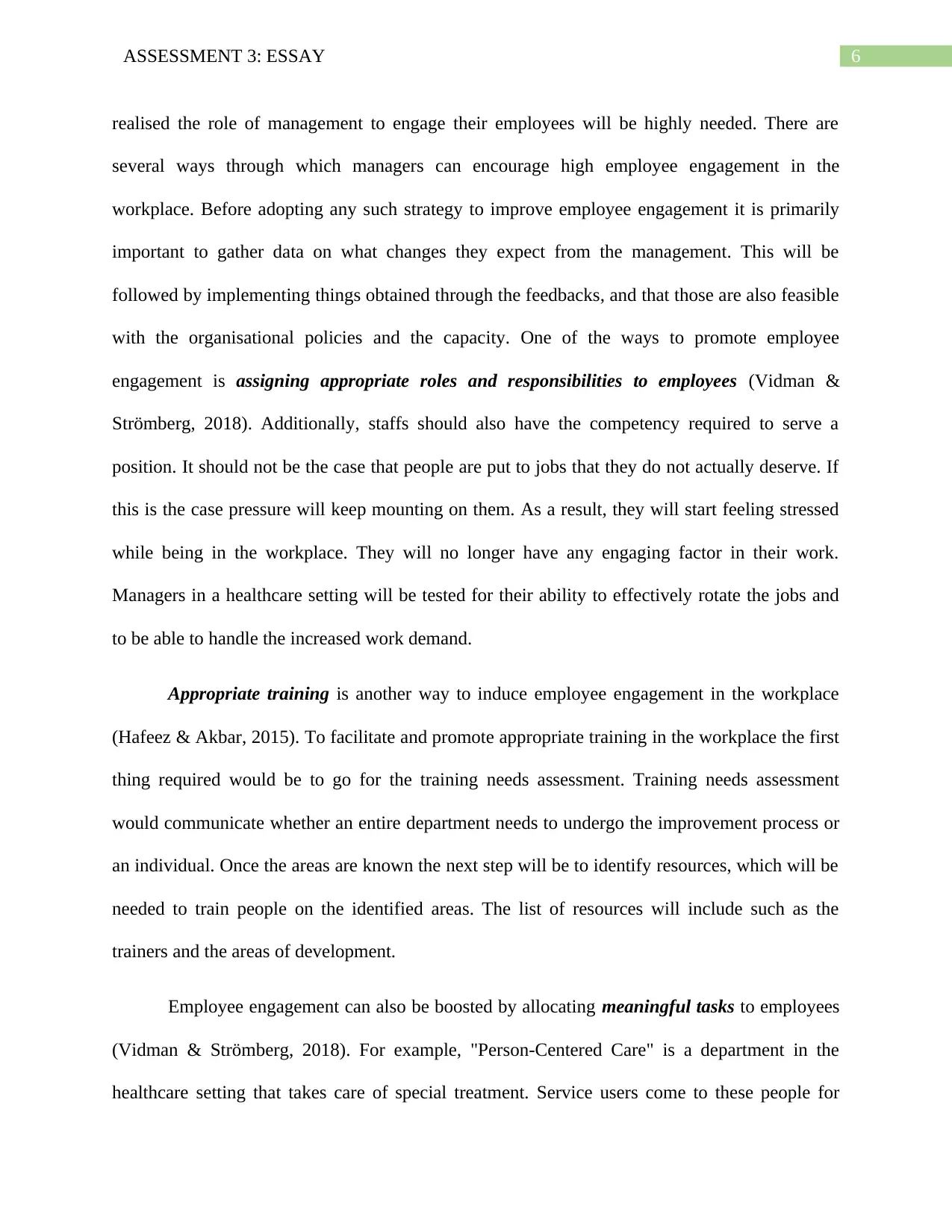
6ASSESSMENT 3: ESSAY
realised the role of management to engage their employees will be highly needed. There are
several ways through which managers can encourage high employee engagement in the
workplace. Before adopting any such strategy to improve employee engagement it is primarily
important to gather data on what changes they expect from the management. This will be
followed by implementing things obtained through the feedbacks, and that those are also feasible
with the organisational policies and the capacity. One of the ways to promote employee
engagement is assigning appropriate roles and responsibilities to employees (Vidman &
Strömberg, 2018). Additionally, staffs should also have the competency required to serve a
position. It should not be the case that people are put to jobs that they do not actually deserve. If
this is the case pressure will keep mounting on them. As a result, they will start feeling stressed
while being in the workplace. They will no longer have any engaging factor in their work.
Managers in a healthcare setting will be tested for their ability to effectively rotate the jobs and
to be able to handle the increased work demand.
Appropriate training is another way to induce employee engagement in the workplace
(Hafeez & Akbar, 2015). To facilitate and promote appropriate training in the workplace the first
thing required would be to go for the training needs assessment. Training needs assessment
would communicate whether an entire department needs to undergo the improvement process or
an individual. Once the areas are known the next step will be to identify resources, which will be
needed to train people on the identified areas. The list of resources will include such as the
trainers and the areas of development.
Employee engagement can also be boosted by allocating meaningful tasks to employees
(Vidman & Strömberg, 2018). For example, "Person-Centered Care" is a department in the
healthcare setting that takes care of special treatment. Service users come to these people for
realised the role of management to engage their employees will be highly needed. There are
several ways through which managers can encourage high employee engagement in the
workplace. Before adopting any such strategy to improve employee engagement it is primarily
important to gather data on what changes they expect from the management. This will be
followed by implementing things obtained through the feedbacks, and that those are also feasible
with the organisational policies and the capacity. One of the ways to promote employee
engagement is assigning appropriate roles and responsibilities to employees (Vidman &
Strömberg, 2018). Additionally, staffs should also have the competency required to serve a
position. It should not be the case that people are put to jobs that they do not actually deserve. If
this is the case pressure will keep mounting on them. As a result, they will start feeling stressed
while being in the workplace. They will no longer have any engaging factor in their work.
Managers in a healthcare setting will be tested for their ability to effectively rotate the jobs and
to be able to handle the increased work demand.
Appropriate training is another way to induce employee engagement in the workplace
(Hafeez & Akbar, 2015). To facilitate and promote appropriate training in the workplace the first
thing required would be to go for the training needs assessment. Training needs assessment
would communicate whether an entire department needs to undergo the improvement process or
an individual. Once the areas are known the next step will be to identify resources, which will be
needed to train people on the identified areas. The list of resources will include such as the
trainers and the areas of development.
Employee engagement can also be boosted by allocating meaningful tasks to employees
(Vidman & Strömberg, 2018). For example, "Person-Centered Care" is a department in the
healthcare setting that takes care of special treatment. Service users come to these people for
Paraphrase This Document
Need a fresh take? Get an instant paraphrase of this document with our AI Paraphraser

7ASSESSMENT 3: ESSAY
seeking their assistance on special issues like smoking. In case, the staff who takes care of such
an issue is not the right person for the position, this will result in adverse consequences. Time
and money, which the service user has invested to avail of this special service will go in vein.
Consequently, the rate of customer dissatisfaction will increase. Additionally, staff satisfaction
rate will also fall as he or she will feel incompetent for the position they were being hired for
(Mas-Machuca, Berbegal-Mirabent & Alegre, 2016). Hence, it makes sense that leaders and
decision-makers in a healthcare setting should be able to allocate meaningful tasks to their
people or else they will lose a few of their people just because of the problem.
To conclude, it can be said that the workplace culture affects its people and the
operations’ output. It is even more important in context to a healthcare setting as the healthcare
industry is highly customer-oriented. Additionally, most of the jobs offered in this industry are
highly stressful. This is due to all these reasons attrition is high and that employee engagement is
also very low. To reduce the attrition of employees and enhance employee engagement, industry
leaders should consider some of the advice provided with this study. To improve employee
engagement in a healthcare setting it is important to find the best fit for a job position. Moreover,
meaningful tasks should only be allocated to the staffs as they will have the confidence to fulfill
the expectations of the management from them. Effective training should be arranged for those
who need this. This will help the staffs to groom their capability being an employee in a
healthcare setting.
seeking their assistance on special issues like smoking. In case, the staff who takes care of such
an issue is not the right person for the position, this will result in adverse consequences. Time
and money, which the service user has invested to avail of this special service will go in vein.
Consequently, the rate of customer dissatisfaction will increase. Additionally, staff satisfaction
rate will also fall as he or she will feel incompetent for the position they were being hired for
(Mas-Machuca, Berbegal-Mirabent & Alegre, 2016). Hence, it makes sense that leaders and
decision-makers in a healthcare setting should be able to allocate meaningful tasks to their
people or else they will lose a few of their people just because of the problem.
To conclude, it can be said that the workplace culture affects its people and the
operations’ output. It is even more important in context to a healthcare setting as the healthcare
industry is highly customer-oriented. Additionally, most of the jobs offered in this industry are
highly stressful. This is due to all these reasons attrition is high and that employee engagement is
also very low. To reduce the attrition of employees and enhance employee engagement, industry
leaders should consider some of the advice provided with this study. To improve employee
engagement in a healthcare setting it is important to find the best fit for a job position. Moreover,
meaningful tasks should only be allocated to the staffs as they will have the confidence to fulfill
the expectations of the management from them. Effective training should be arranged for those
who need this. This will help the staffs to groom their capability being an employee in a
healthcare setting.

8ASSESSMENT 3: ESSAY
References:
Ahmed, S., Tarique, K. M., & Arif, I. (2017). Service quality, patient satisfaction and loyalty in
the Bangladesh healthcare sector. International Journal of health care quality
assurance, 30(5), 477-488. [DOI: 10.1108/IJHCQA-01-2017-0004]
Arifin, H. M. (2015). The Influence of Competence, Motivation, and Organisational Culture to
High School Teacher Job Satisfaction and Performance. International Education
Studies, 8(1), 38-45. [DOI: 10.5539/ies.v8n1p38]
Beugelsdijk, S., Kostova, T., & Roth, K. (2017). An overview of Hofstede-inspired country-level
culture research in international business since 2006. Journal of International Business
Studies, 48(1), 30-47. [DOI: 10.1057/s41267-016-0038-8]
Coccia, M. (2015). Structure and organisational behaviour of public research institutions under
unstable growth of human resources. Coccia, M.(2014)‘Structure and organisational
behaviour of public research institutions under unstable growth of human resources’,
Int. J. Services Technology and Management, 20(4/5), 6.
Exprúa, J., & Barberena, L. R. (2016). The Caribbean Medical Center case: Marketing decision-
making for hospitals facing customer attrition. Journal of Business Research, 69(9),
3878-3885. [DOI: 10.1016/j.jbusres.2015.11.019]
Fang, D., Wu, C., & Wu, H. (2015). Impact of the supervisor on worker safety behavior in
construction projects. Journal of Management in Engineering, 31(6), 04015001. [DOI:
10.1061/(ASCE)ME.1943-5479.0000355]
References:
Ahmed, S., Tarique, K. M., & Arif, I. (2017). Service quality, patient satisfaction and loyalty in
the Bangladesh healthcare sector. International Journal of health care quality
assurance, 30(5), 477-488. [DOI: 10.1108/IJHCQA-01-2017-0004]
Arifin, H. M. (2015). The Influence of Competence, Motivation, and Organisational Culture to
High School Teacher Job Satisfaction and Performance. International Education
Studies, 8(1), 38-45. [DOI: 10.5539/ies.v8n1p38]
Beugelsdijk, S., Kostova, T., & Roth, K. (2017). An overview of Hofstede-inspired country-level
culture research in international business since 2006. Journal of International Business
Studies, 48(1), 30-47. [DOI: 10.1057/s41267-016-0038-8]
Coccia, M. (2015). Structure and organisational behaviour of public research institutions under
unstable growth of human resources. Coccia, M.(2014)‘Structure and organisational
behaviour of public research institutions under unstable growth of human resources’,
Int. J. Services Technology and Management, 20(4/5), 6.
Exprúa, J., & Barberena, L. R. (2016). The Caribbean Medical Center case: Marketing decision-
making for hospitals facing customer attrition. Journal of Business Research, 69(9),
3878-3885. [DOI: 10.1016/j.jbusres.2015.11.019]
Fang, D., Wu, C., & Wu, H. (2015). Impact of the supervisor on worker safety behavior in
construction projects. Journal of Management in Engineering, 31(6), 04015001. [DOI:
10.1061/(ASCE)ME.1943-5479.0000355]
⊘ This is a preview!⊘
Do you want full access?
Subscribe today to unlock all pages.

Trusted by 1+ million students worldwide
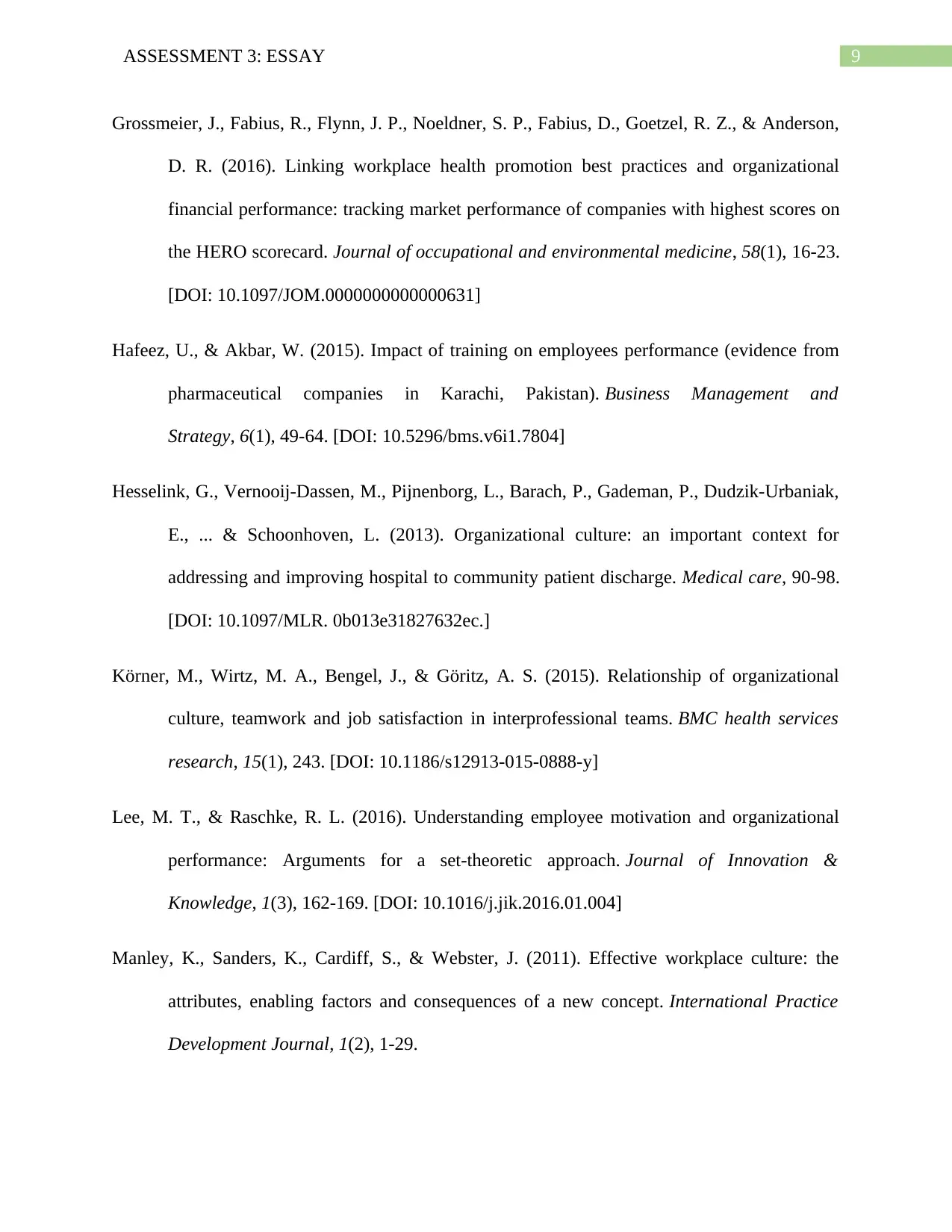
9ASSESSMENT 3: ESSAY
Grossmeier, J., Fabius, R., Flynn, J. P., Noeldner, S. P., Fabius, D., Goetzel, R. Z., & Anderson,
D. R. (2016). Linking workplace health promotion best practices and organizational
financial performance: tracking market performance of companies with highest scores on
the HERO scorecard. Journal of occupational and environmental medicine, 58(1), 16-23.
[DOI: 10.1097/JOM.0000000000000631]
Hafeez, U., & Akbar, W. (2015). Impact of training on employees performance (evidence from
pharmaceutical companies in Karachi, Pakistan). Business Management and
Strategy, 6(1), 49-64. [DOI: 10.5296/bms.v6i1.7804]
Hesselink, G., Vernooij-Dassen, M., Pijnenborg, L., Barach, P., Gademan, P., Dudzik-Urbaniak,
E., ... & Schoonhoven, L. (2013). Organizational culture: an important context for
addressing and improving hospital to community patient discharge. Medical care, 90-98.
[DOI: 10.1097/MLR. 0b013e31827632ec.]
Körner, M., Wirtz, M. A., Bengel, J., & Göritz, A. S. (2015). Relationship of organizational
culture, teamwork and job satisfaction in interprofessional teams. BMC health services
research, 15(1), 243. [DOI: 10.1186/s12913-015-0888-y]
Lee, M. T., & Raschke, R. L. (2016). Understanding employee motivation and organizational
performance: Arguments for a set-theoretic approach. Journal of Innovation &
Knowledge, 1(3), 162-169. [DOI: 10.1016/j.jik.2016.01.004]
Manley, K., Sanders, K., Cardiff, S., & Webster, J. (2011). Effective workplace culture: the
attributes, enabling factors and consequences of a new concept. International Practice
Development Journal, 1(2), 1-29.
Grossmeier, J., Fabius, R., Flynn, J. P., Noeldner, S. P., Fabius, D., Goetzel, R. Z., & Anderson,
D. R. (2016). Linking workplace health promotion best practices and organizational
financial performance: tracking market performance of companies with highest scores on
the HERO scorecard. Journal of occupational and environmental medicine, 58(1), 16-23.
[DOI: 10.1097/JOM.0000000000000631]
Hafeez, U., & Akbar, W. (2015). Impact of training on employees performance (evidence from
pharmaceutical companies in Karachi, Pakistan). Business Management and
Strategy, 6(1), 49-64. [DOI: 10.5296/bms.v6i1.7804]
Hesselink, G., Vernooij-Dassen, M., Pijnenborg, L., Barach, P., Gademan, P., Dudzik-Urbaniak,
E., ... & Schoonhoven, L. (2013). Organizational culture: an important context for
addressing and improving hospital to community patient discharge. Medical care, 90-98.
[DOI: 10.1097/MLR. 0b013e31827632ec.]
Körner, M., Wirtz, M. A., Bengel, J., & Göritz, A. S. (2015). Relationship of organizational
culture, teamwork and job satisfaction in interprofessional teams. BMC health services
research, 15(1), 243. [DOI: 10.1186/s12913-015-0888-y]
Lee, M. T., & Raschke, R. L. (2016). Understanding employee motivation and organizational
performance: Arguments for a set-theoretic approach. Journal of Innovation &
Knowledge, 1(3), 162-169. [DOI: 10.1016/j.jik.2016.01.004]
Manley, K., Sanders, K., Cardiff, S., & Webster, J. (2011). Effective workplace culture: the
attributes, enabling factors and consequences of a new concept. International Practice
Development Journal, 1(2), 1-29.
Paraphrase This Document
Need a fresh take? Get an instant paraphrase of this document with our AI Paraphraser
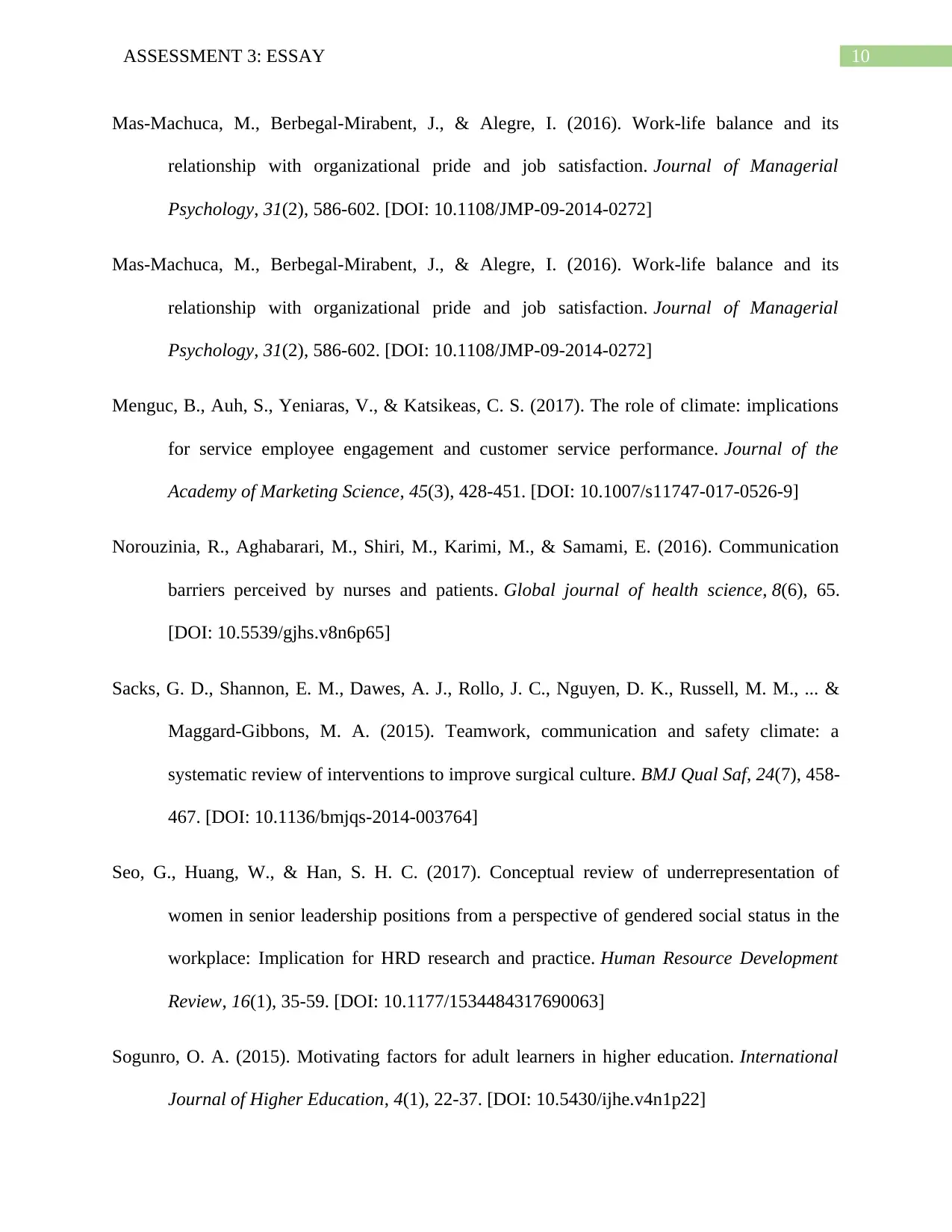
10ASSESSMENT 3: ESSAY
Mas-Machuca, M., Berbegal-Mirabent, J., & Alegre, I. (2016). Work-life balance and its
relationship with organizational pride and job satisfaction. Journal of Managerial
Psychology, 31(2), 586-602. [DOI: 10.1108/JMP-09-2014-0272]
Mas-Machuca, M., Berbegal-Mirabent, J., & Alegre, I. (2016). Work-life balance and its
relationship with organizational pride and job satisfaction. Journal of Managerial
Psychology, 31(2), 586-602. [DOI: 10.1108/JMP-09-2014-0272]
Menguc, B., Auh, S., Yeniaras, V., & Katsikeas, C. S. (2017). The role of climate: implications
for service employee engagement and customer service performance. Journal of the
Academy of Marketing Science, 45(3), 428-451. [DOI: 10.1007/s11747-017-0526-9]
Norouzinia, R., Aghabarari, M., Shiri, M., Karimi, M., & Samami, E. (2016). Communication
barriers perceived by nurses and patients. Global journal of health science, 8(6), 65.
[DOI: 10.5539/gjhs.v8n6p65]
Sacks, G. D., Shannon, E. M., Dawes, A. J., Rollo, J. C., Nguyen, D. K., Russell, M. M., ... &
Maggard-Gibbons, M. A. (2015). Teamwork, communication and safety climate: a
systematic review of interventions to improve surgical culture. BMJ Qual Saf, 24(7), 458-
467. [DOI: 10.1136/bmjqs-2014-003764]
Seo, G., Huang, W., & Han, S. H. C. (2017). Conceptual review of underrepresentation of
women in senior leadership positions from a perspective of gendered social status in the
workplace: Implication for HRD research and practice. Human Resource Development
Review, 16(1), 35-59. [DOI: 10.1177/1534484317690063]
Sogunro, O. A. (2015). Motivating factors for adult learners in higher education. International
Journal of Higher Education, 4(1), 22-37. [DOI: 10.5430/ijhe.v4n1p22]
Mas-Machuca, M., Berbegal-Mirabent, J., & Alegre, I. (2016). Work-life balance and its
relationship with organizational pride and job satisfaction. Journal of Managerial
Psychology, 31(2), 586-602. [DOI: 10.1108/JMP-09-2014-0272]
Mas-Machuca, M., Berbegal-Mirabent, J., & Alegre, I. (2016). Work-life balance and its
relationship with organizational pride and job satisfaction. Journal of Managerial
Psychology, 31(2), 586-602. [DOI: 10.1108/JMP-09-2014-0272]
Menguc, B., Auh, S., Yeniaras, V., & Katsikeas, C. S. (2017). The role of climate: implications
for service employee engagement and customer service performance. Journal of the
Academy of Marketing Science, 45(3), 428-451. [DOI: 10.1007/s11747-017-0526-9]
Norouzinia, R., Aghabarari, M., Shiri, M., Karimi, M., & Samami, E. (2016). Communication
barriers perceived by nurses and patients. Global journal of health science, 8(6), 65.
[DOI: 10.5539/gjhs.v8n6p65]
Sacks, G. D., Shannon, E. M., Dawes, A. J., Rollo, J. C., Nguyen, D. K., Russell, M. M., ... &
Maggard-Gibbons, M. A. (2015). Teamwork, communication and safety climate: a
systematic review of interventions to improve surgical culture. BMJ Qual Saf, 24(7), 458-
467. [DOI: 10.1136/bmjqs-2014-003764]
Seo, G., Huang, W., & Han, S. H. C. (2017). Conceptual review of underrepresentation of
women in senior leadership positions from a perspective of gendered social status in the
workplace: Implication for HRD research and practice. Human Resource Development
Review, 16(1), 35-59. [DOI: 10.1177/1534484317690063]
Sogunro, O. A. (2015). Motivating factors for adult learners in higher education. International
Journal of Higher Education, 4(1), 22-37. [DOI: 10.5430/ijhe.v4n1p22]

11ASSESSMENT 3: ESSAY
Thomson, K., Outram, S., Gilligan, C., & Levett-Jones, T. (2015). Interprofessional experiences
of recent healthcare graduates: A social psychology perspective on the barriers to
effective communication, teamwork, and patient-centred care. Journal of
interprofessional care, 29(6), 634-640. [DOI: 10.3109/13561820.2015.1040873]
Vidman, Å., & Strömberg, A. (2018). “Well it is for their sake we are here”: meaningful work
tasks from care workers’ view. Working with Older People, 22(2), 111-120. [DOI:
10.1108/WWOP-09-2017-0024]
Yazdani, A., & Wells, R. (2018). Barriers for implementation of successful change to prevent
musculoskeletal disorders and how to systematically address them. Applied
ergonomics, 73, 122-140. [DOI: 10.1016/j.apergo.2018.05.004]
Thomson, K., Outram, S., Gilligan, C., & Levett-Jones, T. (2015). Interprofessional experiences
of recent healthcare graduates: A social psychology perspective on the barriers to
effective communication, teamwork, and patient-centred care. Journal of
interprofessional care, 29(6), 634-640. [DOI: 10.3109/13561820.2015.1040873]
Vidman, Å., & Strömberg, A. (2018). “Well it is for their sake we are here”: meaningful work
tasks from care workers’ view. Working with Older People, 22(2), 111-120. [DOI:
10.1108/WWOP-09-2017-0024]
Yazdani, A., & Wells, R. (2018). Barriers for implementation of successful change to prevent
musculoskeletal disorders and how to systematically address them. Applied
ergonomics, 73, 122-140. [DOI: 10.1016/j.apergo.2018.05.004]
⊘ This is a preview!⊘
Do you want full access?
Subscribe today to unlock all pages.

Trusted by 1+ million students worldwide
1 out of 12
Related Documents
Your All-in-One AI-Powered Toolkit for Academic Success.
+13062052269
info@desklib.com
Available 24*7 on WhatsApp / Email
![[object Object]](/_next/static/media/star-bottom.7253800d.svg)
Unlock your academic potential
Copyright © 2020–2025 A2Z Services. All Rights Reserved. Developed and managed by ZUCOL.





